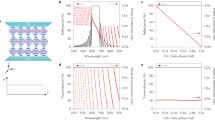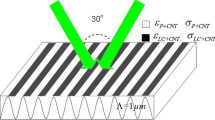Abstract
Based on the analytical expression of the electromagnetic field solution of a helical symmetric dielectric material, the relationship between spectral reflectivity and birefringence of a chiral liquid crystal and the blue shift of the Bragg reflection in the condition of oblique incidence are presented in this paper. The theoretical results indicated that: 1) If birefringence (Δn) of the liquid crystal is greater than 0.2 and the thickness of the liquid crystal layer reaches 3 μm, the liquid crystal layer will reflect more than 90% of the incident light; 2) To reflect the whole visible spectrum by Bragg reflection, Δn of the liquid crystals in plane alignment state should exceed 0.6; 3) When the incident beam inclines to 60° from the normal direction, the blue shift of the reflective spectrum will reach to 100 nm. On the other hand, since the Δn of the commercial chiral liquid crystals is not larger than 0.2, to get the entire visible reflective spectrum, it needs to introduce a polymer network into the liquid crystals and make a sagging structure on the surface of substrates. The contribution of the network is to establish random anchorage that makes the pitch varied, hence broadening the Bragg reflection spectra. The random distribution of the sagging structure on the surface substrate is used to induce random screw axes of the chiral liquid crystal, which not only causes a blue shift of Bragg reflection but also further stretches the reflection spectra. Experiments demonstrated that the Bragg reflection spectrum could be broadened from 80 nm to more than 120 nm, and the contrast reaches 4:1 by introducing both polymer network and sagging structure on the substrate surface cell.
Similar content being viewed by others
References
Held G A, Dierking I, Kosbar L L, et al. Network morphology and switching transitions in polymer stabilized Cholesteric textures. Molecular Crystals and Liquid Crystals, 1999, 329(1): 473–481
Guillard H, Sixou P, Reboul L, et al. Electrooptical characterizations of polymer stabilized cholesteric liquid crystals. Polymer, 2001, 42(24): 9753–9762
Kang K, Chien L C, Sprunt S. Polymer-stabilized cholesteric liquid crystal microgratings: a comparison of polymer network formation and electro-optic properties for mesogenic and non-mesogenic monomers. Liquid Crystals, 2002, 29(1): 9–18
Priestley E B, Wojtowics P J, Sheng P. Introduction to Liquid Crystal. London: Plenum Press. 1974, 203–216
Moriya N, Uchida T, Matsushima K. Novel transmissive color filter using cholesteric liquid crystal with wide viewing angle. Journal of the Society for Information Display, 2003, 11(2): 409–412
Author information
Authors and Affiliations
Corresponding author
Additional information
__________
Translated from Chinese Journal of Liquid Crystals and Displays, 2006, 21(1): 1–5 [译自: 液晶与显示]
Rights and permissions
About this article
Cite this article
Huang, Z., Yang, W. & Wang, J. Reflective spectrum broadened by nano-particle-network in chiral liquid crystals. Front. Optoelectron. China 1, 188–191 (2008). https://doi.org/10.1007/s12200-008-0008-2
Published:
Issue Date:
DOI: https://doi.org/10.1007/s12200-008-0008-2




